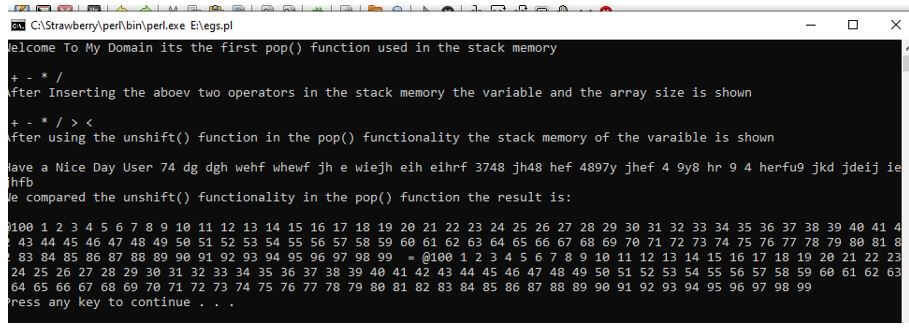Updated April 17, 2023

Introduction to Perl pop
The Perl pop is one of the functions that can be used for to pop the elements in the data structure concepts like a stack, list, arrays etc. the inserting the elements in the LIFO (Last In First Out) position so the user input values are popped out whatever the values are added recently also after popped out the value it can also be passed into the parameters the popped values are explicitly passing to the array after done the popped operation from the array the size is to be reduced automatically in the memory the reference value of that element also be removed from the memory.
Syntax:
The Perl script uses some data structure concepts like push and pop. It is mainly used for manipulates the data, and it reduces the memory to perform the operations quickly. The pop() functionality have to remove the last element from the array or any other data structures in the memory.
@var =(' ');
print pop(@var);
----some perl script codes depends upon the user requirement the perl functions will be called and used in the file---The above codes are the basic syntax for the pop() function used in the Perl script; the user input values are popped out on the data structures.
How does the pop Function work in Perl?
- The Perl script uses some default functions, keywords, variables for creating the sophisticated applications. Likewise, we use some data structures concepts like an array, stack, queue, push, pop, shift etc., for securing the datas as well as reduce the data usages in the memory location. Perl array uses a pop() function for removing the last element of the array; it also pointed out the stack in data collections and structure concepts. It also used for to remove as well as return or pop the last element from the array.
- This is meant by to reduce the number of elements in the array. Generally, the last stage or position of the element is the highest level of the index is generated automatically in the stack memory. Also, the pop() function of the elements are chopped off the elements from the right side positions of the array list, and it will return the element as soon as to reduce the element size automatically with one by one in the memory. The array elements are also thought of as the stack for the numbered boxes that are top to bottom, and increasing the element size goes down so that the bottom of the stack memory is popped out in the memory.
Examples of Perl pop
Given below are the examples of Perl pop:
Example #1
Code:
#!/usr/bin/perl -w
@var = (7654,3876,2736,91237,237,9273,36483,12973,2739,918723,9273,8263,912873,9812732,973924,192873184,9210838,91723,90238,921838);
print("Welcome To My Domain", pop(@var), "After using the pop() function in the script it return the value as recently removed in the list",@var, "\n")Output:
In the above example, we used a basic variable like @var to initialise the values; it will be lengthy to store them in the array. So each value has a separate reference, and it holds the reference to the stack memory location because when we removed the particular element in the stack, it also holds the reference keep on the memory so the memory loss will be occurred due to avoid the memory leaks and consumption it removes in the memory. If we use the pop() function, it removes the last element in the array that is left to right position; the last position of the element is 921838 it will be removed in the stack memory.
Example #2
Code:
use strict;
use warnings;
my @var = qw(+ - * / %);
pop @var;
print "Welcome To My Domain its the first pop() function used in the stack memory \n \n @var\n";
push(@var, '>', '<');
print "After Inserting the aboev two operators in the stack memory the variable and the array size is shown \n \n @var \n";
my @var1 = qw(74 dg dgh wehf whewf jh e wiejh eih eihrf 3748 jh48 hef 4897y jhef 4 9y8 hr 9 4 herfu9 jkd jdeij iejhfb wefih);
pop (@var1);
unshift @var1, 'Have a Nice Day User';
print "After using the unshift() function in the pop() functionality the stack memory of the varaible is shown \n \n@var1\n";
my @demo = ('1'..'100');
unshift(@demo, pop(@demo));
print "We compared the unshift() functionality in the pop() function the result is: \n \n\@@demo = @@demo\n";Output:
In the second example, we used some different functions like unshift and push() in pop() functionality. After removing the last element in the stack, the memory reference of the particular value has also been empty. It is in null space, so it will be occupied with the other elements by using the push() operation; it will be inserted in the array list. When we use unshift() function, we can call the pop() function and the user input variable to compare the two functionality in the script. Here we used 1..100 in the variable @demo; it will be called in the unshift(@demo, pop(@demo)) method for comparing the same variable values for the different purposes.
Example #3
Code:
use strict;
use warnings;
my $var = pop @{[split m|k|, "www.facebook.com"]};
print "Welcome User after using the split() function in pop() out the result is: \n $var\n";
my $var1 = ['55gtg', 'fu', 'erhgfb', 'jwehg', 'jehwgfvj'];
pop @$var1;
print "Have a Nice day user after popped out the elements from the array list is: @{$var1}\n"Output:
In the final example, we used the one more additional function as a split for splitting the characters in the given strings. It’s also the string functionality, so it will split the strings into the each character so by using the delimiters, i.e.) here we used m|k| here the ‘m’ is the keyword and using | | symbol inside that ‘k’ is the character, so after ‘k’ all other values are listed in the pop function so that will be shown and it will return in the output console. It is one of the basic functionality for split used in the pop() function.
Conclusion
In concluded part, the Perl script used a lot of default methods with their properties in the application. Likewise, pop() is one of the pretty functionality for the data structure using the Perl script. Using these functions, we will remove the last element from the data structure and reduce the memory.
Recommended Articles
This is a guide to Perl pop. Here we discuss the introduction; how does pop function work in Perl? and examples, respectively. You may also have a look at the following articles to learn more –




